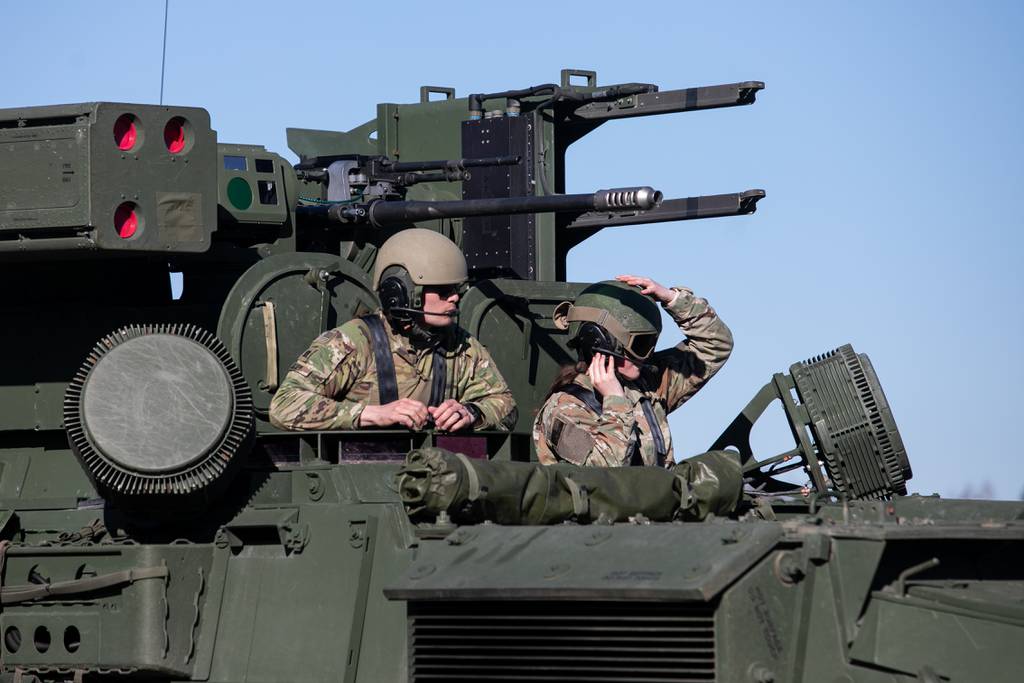The M6 Bradley with stingers in the missile box is called Linebacker.
The name Linebacker was chosen for the ADATS in 1991 after a poll of ADA troops. The BSFV merely adopted it.
Selecting ADATS doesn't seem like it was a mistake to me. The problem was the threat collapsed and it was an easy target for cuts which is generally always a true statement for Army Air Defense.
It doesn't seem like a mistake because ADATS was never tested against Vikhr, obviously. It was simulated against Kokon/Ataka.
Ka-52s shooting targets at well over 10km with what?
No one has said this. Vikhr has a range of about 10 km. This is about 25% longer than ADATS on a typical day.
The range of ADATS is approximately 10km as well.
No, it's around 7-8 kilometers. It's comparable to Rapier in general except it has a heavier, dual-purpose warhead and a faster rocket motor. Liberty was the only air defense system in the FAADS LOS-F-H competition that had a double digit kilometer range.
Of course Liberty was the biggest and heaviest of the competitors.
Circumstances are still going to dictate that attack helicopters will often have to engage at distances shorter than the maximum range of their missiles anyway.
None of which would be beneficial to ADATS...
The purpose of ADATS was pretty simple. A helicopter pops up on a treeline about 5-6 km away, fires a ATGW, and the air defense system responds with a counter missile that reaches the helicopter before the ATGW reaches the tank or fire unit. It's the exact same as Sgt. York except it involves a missile instead of a gun.
The problem was the threat collapsed and it was an easy target for cuts which is generally always a true statement for Army Air Defense.
Yes, that's why the Air Defense Artillery received literal millions through the 1990's to develop the FOG-M and EFOGM and the TWQ-1?
The actual reason is ADATS was a missile version of the Sergeant York. It was highly unreliable, somewhat short ranged, and a backwards weapon compared to literally imminent future threats. It's a thing that would have been outdated by the time it entered production. That's why CSA Vuono and the OSD talked to ADA about it and they all agreed to kill it in FY92. Before that, the Army had pushed back its plan to enter ADATS into LRIP in FY91 to FY93, pending the outcome of the RD&E program to fix the system.
And FWIW, no the "threat" didn't disappear. Expectations of threat air defense development in the 1990's were similar to the 1980's, with a greater emphasis on post-Soviet Russian export of weapons to the Third World to compensate for the lack of internal tax revenues of the USSR, including the Mi-28 and Ka-50, and proliferation of advanced combat weapons like the Su-25T and Vikhr as opposed to the Mi-35 and Kokon/Ataka.
In some ways, the projected air defense environment anticipated in the early 1990's was worse than it was in the 1980's. The Soviet Union had a scary air assault force, but that was one theater of one continent of one highly unlikely war. The Russians were threatening to turn every Tom, Dick, and Hussein into miniature forms of its own airborne forces just to keep their lights on, which means you could face a Soviet-style and Soviet-grade air threat from Iraq, Serbia, or Libya in the coming decades.
tl;dr ADATS died mostly because of internal Army reasons, not because "the politicians" killed it because "the threat" had "vanished".
The threat existed, and still exists, and the need for a short-range missile is still fairly important these days. The problem is that short range has gone from being 7-8 km in the 1980's to more like 20-30 km in the 2010's. How do you intend to fight a system like Israeli Spike-NLOS, the Indian NAG-SANT, or Russian LMUR without genuine BLOS capability? You really can't.
We'd still be stuck with ADATS today if we had bought it and it's unlikely it would provide much utility because the motor is very small and the warhead is very heavy. You'd need a new missile to reach what VT-1 did, and to go to what Mk 3 Crotale does, you'd need an entirely new combat system. We'll leave out that it's laser guided and thus incapable of proper BLOS, while a radar guided missile can theoretically do CEC.
I don't even know what ADATS would do in the IAMD architecture. It's not radar guided so it's not like a Patriot or Sentinel can just tell an ADATS to attack a target the launcher can't see. You'd need some goofball laser- and radio-dual datalink and nobody is gonna fund that, they'd just tell you to stick a AMRAAM on a Bradley or something.

